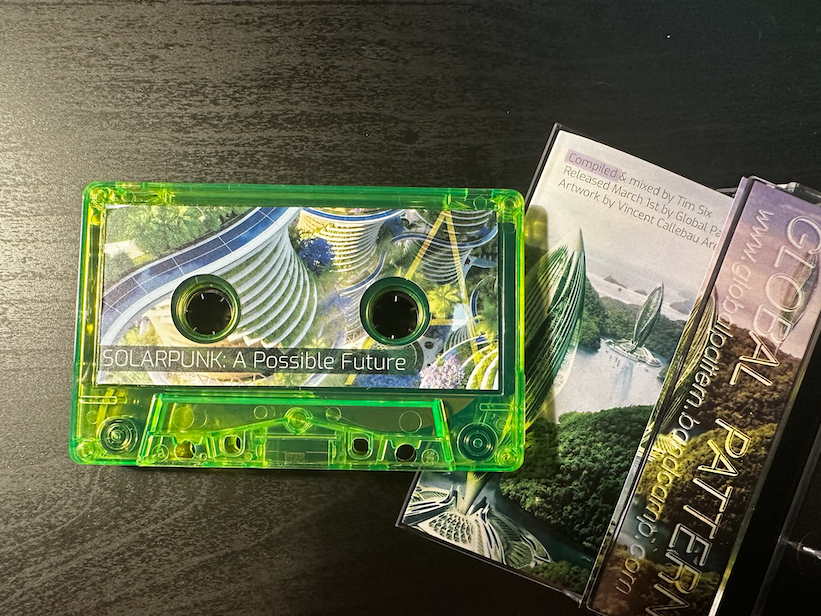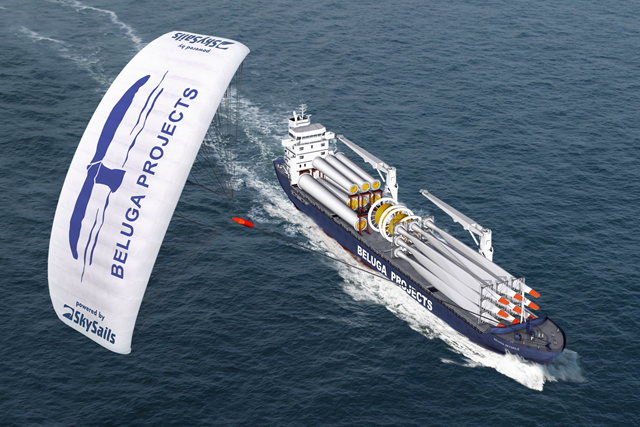.png)
You've discovered my Solarpunk temple! Welcome.
My introduction to Solarpunk happened by random chance at a record store in Texas. I was browsing the cassette tapes and came across this translucent neon green tape with a biomorphic building on the cover. It was sick as hell so I bought it immediately, despite not knowing anything about the music; I figured that even if it wasn't any good, the cool ass tape alone would justify the price. (I also happen to love biomorphic architecture... so yeah, I was definitely taking this baddie back to my place.) And here is the baddie in question:

The album is called "Solarpunk: A Possible Future", by Global Pattern -- and I lied because it is technically not an album but instead a compilation of Solarpunk-inspired songs from several artists involved with a music label called Global Pattern. (I'm telling you this because I searched for the musical artist Global Pattern for a while before I realized I was barking up the wrong tree. Also their label has a lot of really cool releases and you should check out their Bandcamp, which I have linked above.) And there's another surprise twist: you're hearing this album now! If you have autoplay enabled, that is. Or you can play it by clicking "play" on the mp3 player at the bottom of your screen.
The music is peaceful, ambient, and atmospheric. "But what does it represent? What *is* Solarpunk?" I hear you asking. Well, I'll tell you.
Origins of Solarpunk
Solarpunk began as a literary genre; it's thought that the term was coined in this blog post from 2008. In it, the author describes a cargo vessel which had just finished its maiden voyage: The MS Onego Deusto, or Beluga Skysails. In 2008, she became the world's first shipping vessel to employ a computer-controlled sail system.

The "SkySails system" was introduced for practical reasons -- namely, to reduce emissions and fuel costs -- but its design signaled something more romantic: a return to the billowing canvas sails of antiquity. This revival of Victorian-era renewable energy was inspiring to the author, who quickly formed the idea of "Solarpunk":
"I think the best way to explain Solarpunk is by contrasting it to the science fiction and fantasy genre called steampunk, from which the idea of Solarpunk derives. Steampunk stories describe alternative futures or worlds in which steam technology (and Victorian technologies in general) were not pushed aside by oil-based technologies. For example, in many steampunk stories, mechanical devices have not been replaced by electrical ones, since without oil the world never developed the capacity to generate the massive amounts of electricity that we take for granted."
A writer called Ian Dennis Miller has compiled a collection of Solarpunk writings and resources, and from them he has synthezised a "Solarpunk Manifesto", which describes the key elements of the ideology:
"At its core, Solarpunk is a vision of a future that embodies the best of what humanity can achieve: a post-scarcity, post-hierarchy, post-capitalistic world where humanity sees itself as part of nature and clean energy replaces fossil fuels. The “punk” in Solarpunk is about rebellion, counterculture, post-capitalism, decolonialism and enthusiasm. It is about going in a different direction than the mainstream."
Having a tendency toward meliorism, I'm certainly predisposed to liking this aesthetic. And like it I do. When I got thinking about it, I realized that I had actually seen Solarpunk-adjacent concepts in some of my favorite media, which I will briefly summarize for you now:
Treasure Planet
Where to start with this movie? What a classic. Treasure Planet is a Disney animated movie from 2002, which means it was produced right in the middle of that really amazing "golden era" of Disney animation. (In fact, this particular movie had a budget of $140 million, which makes it the most expensive traditionally animated film ever made, to date.) If you haven't seen it, it's a sci-fi adaptation of the classic novel Treasure Island by Robert Louis Stevenson. What really strikes me about this movie, though, has always been its worldbuilding. You see, ships in the TPCU (Treasure Planet Cinematic Universe) use solar sails to sail around the cosmos. And I didn't know this until I was researching to write this, but solar sails are actually a real thing in the real world, and they turn radiation from the sun into pressure to propel spacecraft. That's so wild. Scientists are so smart.
So anyway, the protagonist Jim is this edgy teen and he has the coolest solar sail skateboard thing ever. You just have to watch this clip of him flying around on it, because it's SO SOLARPUNK:
(Also, I feel like I should link to this French fan page for "Le Planete Au Tresor" that I came across while looking for content about this movie. It's just a really cute fansite from 2002.)
---- This section is still under construction, please come back soon !! ----
Last updated 11/6/24


